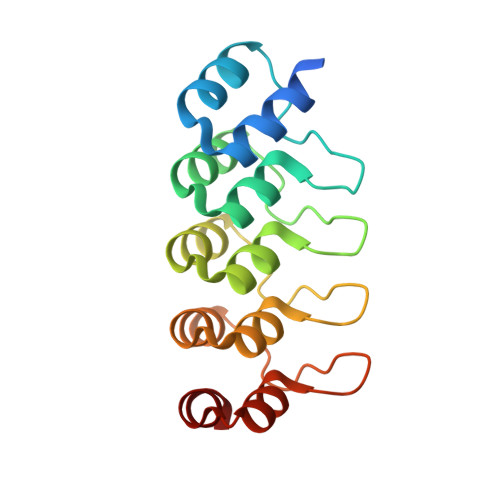Stabilizing ionic interactions in a full-consensus ankyrin repeat protein.
Merz, T., Wetzel, S.K., Firbank, S., Pluckthun, A., Grutter, M.G., Mittl, P.R.E.(2008) J Mol Biol 376: 232-240
- PubMed: 18155045
- DOI: https://doi.org/10.1016/j.jmb.2007.11.047
- Primary Citation of Related Structures:
2QYJ - PubMed Abstract:
Full-consensus designed ankyrin repeat proteins (DARPins), in which randomized positions of the previously described DARPin library have been fixed, are characterized. They show exceptionally high thermodynamic stabilities, even when compared to members of consensus DARPin libraries and even more so when compared to naturally occurring ankyrin repeat proteins. We determined the crystal structure of a full-consensus DARPin, containing an N-capping repeat, three identical internal repeats and a C-capping repeat at 2.05 A resolution, and compared its structure with that of the related DARPin library members E3_5 and E3_19. This structural comparison suggests that primarily salt bridges on the surface, which arrange in a network with almost crystal-like regularity, increase thermostability in the full-consensus NI(3)C DARPin to make it resistant to boiling. In the crystal structure, three sulfate ions complement this network. Thermal denaturation experiments in guanidine hydrochloride directly indicate a contribution of sulfate binding to the stability, providing further evidence for the stabilizing effect of surface-exposed electrostatic interactions and regular charge networks. The charged residues at the place of randomized residues in the DARPin libraries were selected based on sequence statistics and suggested that the charge interaction network is a hidden design feature of this protein family. Ankyrins can therefore use design principles from proteins of thermophilic organisms and reach at least similar stabilities.
Organizational Affiliation:
Department of Biochemistry, University of Zürich, Winterthurerstrasse 190, CH-8057 Zürich, Switzerland.















